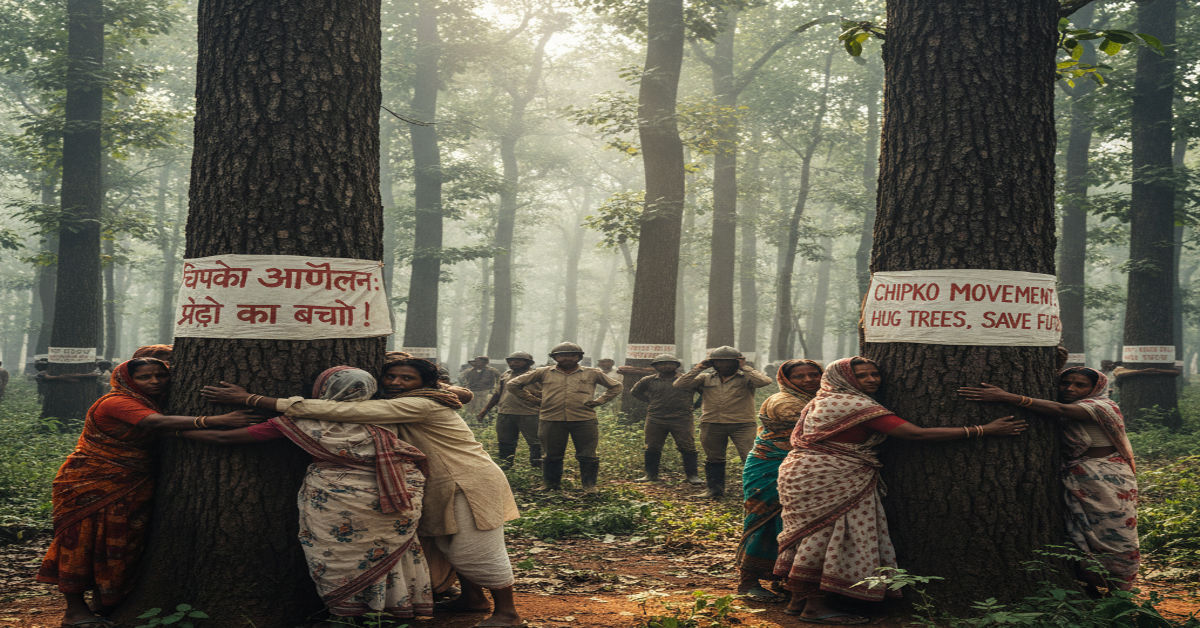In the spring of 1973 in a quiet Himalayan village a group of women wrapped their arms around trees to keep them from being cut down. Their act of defiance—simple yet profound—would come to be known as the Chipko Movement, a term derived from the Hindi word chipakna meaning “to cling.” Within months, this local protest against commercial logging would blossom into one of India’s most powerful environmental awakenings.
The Chipko Movement began as a fight for survival. Villagers in the Garhwal Himalayas relied on their forests for food, water, fuel and shelter. When outside contractors arrived to fell trees for profit, the ecological balance that sustained their lives began to collapse. Landslides grew frequent, springs dried up and soil erosion worsened. The villagers, led largely by women, realized that if the forests vanished, so would their way of life.
By physically embracing the trees, these communities sent a message far beyond their mountains: that conservation is not a luxury of the elite but a necessity of the poor. In a world now haunted by deforestation and climate anxiety, the spirit of Chipko feels uncannily contemporary—a lesson that environmental protection begins with empathy, courage, and the conviction that the earth’s well-being is inseparable from our own.
The Birth of an Ecological Awakening
By the early 1970s, the Himalayan region of Garhwal was witnessing rapid ecological decline. Forests that had long provided villagers with food, fodder, and shelter were being cleared for commercial timber. The government awarded contracts to outside companies, depriving locals of their traditional rights. As hillsides were stripped bare, landslides and water shortages followed.
In response, the Dasholi Gram Swarajya Mandal (DGSM), founded by social reformer Chandi Prasad Bhatt, began promoting village-level self-reliance through sustainable development. When a logging contract threatened their local forests, villagers organized a peaceful protest. Their method—embracing trees to stop the axes—became a symbol of both defiance and devotion to nature.
Timeline of Key Chipko Events
| Year | Event | Location | Key Figure |
| 1973 | First protest using tree-hugging | Mandal Village, Chamoli | Chandi Prasad Bhatt |
| 1974 | Gaura Devi leads Reni protest | Reni Village, Uttarakhand | Gaura Devi |
| 1977 | Movement spreads across Garhwal | Multiple districts | Sunderlal Bahuguna |
| 1980 | Green felling ban imposed | Uttar Pradesh Himalayas | Indira Gandhi |
| 1987 | Receives Right Livelihood Award | Stockholm, Sweden | Movement leaders |
Women at the Heart of the Movement
Chipko was as much a feminist awakening as it was an ecological one. In the rural Himalayas, women bore the brunt of environmental degradation—they collected firewood, fetched water, and tended livestock. As forests vanished, their labor became harder, their days longer, and their villages more vulnerable.
The act of tree-hugging was therefore not symbolic alone—it was an assertion of agency. Ecofeminist scholar Vandana Shiva later observed, “Chipko was women’s ecological revolution—a declaration that the destruction of nature is the destruction of life.”
In defending their forests, these women challenged both economic exploitation and patriarchal norms. They stood not as victims but as guardians of an ancient ecological balance, reminding the world that environmental justice is inseparable from gender equality.
The Economics Beneath the Ecology
Chipko’s emotional appeal often overshadows its economic logic. The forests provided fuel, fodder, and income for mountain communities. When commercial logging diverted these resources, villagers lost livelihoods. A 1976 study by the Indian Forest Institute found that over 60% of local income losses in Garhwal were tied to restricted forest access.
By protesting, the villagers were demanding not charity but fairness. As economist Amartya Sen once remarked, “Chipko was moral economics in motion—rational self-interest expressed through collective conscience.”
The movement’s success proved that economic growth and environmental protection are not mutually exclusive. When managed responsibly, conservation itself can become a source of stability and prosperity.
From Protest to Policy
The persistence of Chipko activists forced policymakers to confront the ecological costs of unchecked exploitation. In 1980, after years of protests and nationwide marches, the Indian government under Indira Gandhi imposed a 15-year ban on green felling in Himalayan forests.
This policy reversal marked a historic acknowledgment: forests were not mere resources but living systems vital to human welfare. The ban later influenced the National Forest Policy of 1988, which emphasized ecological balance and community participation. The 1990s saw the launch of Joint Forest Management (JFM) programs, giving local communities a formal role in conservation.
Policy Impacts Stemming from Chipko
| Policy / Year | Objective | Impact |
| 1980 Green Felling Ban | Stop deforestation in Himalayas | Stabilized slopes, improved soil and water retention |
| 1988 National Forest Policy | Prioritize ecology over revenue | Recognized local community rights |
| 1990 Joint Forest Management | Share forest management authority | Increased forest regeneration and rural livelihoods |
A Movement That Crossed Borders
Chipko’s influence reached far beyond India. Environmentalists across Asia, Africa, and Latin America cited it as proof that communities could resist ecological destruction through peaceful means. Its message echoed at the 1992 Earth Summit in Rio de Janeiro, where global leaders discussed community-based sustainability models.
Historian Ramachandra Guha later called Chipko “the environmentalism of the poor”—a movement born not from ideology but from necessity. It demonstrated that the struggle for sustainability is often led by those with the least power but the most to lose.
Today, global youth movements for climate justice carry the same moral thread: that safeguarding nature is not an abstract ideal but a fight for dignity, equity, and survival.
Lessons for the Climate Age
Half a century later, India still grapples with deforestation, mining, and climate-induced disasters. Yet the essence of Chipko endures—in local forest councils, eco-tourism initiatives, and women-led reforestation programs.
As Dr. Sunita Narain of the Centre for Science and Environment has noted, “Chipko taught us that the environment is not an outsider’s agenda—it’s people’s everyday economy.” This lesson remains vital in an age when environmental policy risks becoming technocratic. Real progress still depends on trust, inclusion, and moral clarity—the same ingredients that made Chipko timeless.
Key Takeaways from the Chipko Movement
- Community First: Grassroots action can shape national and global policy.
- Women’s Leadership: Chipko foregrounded women as central to ecological protection.
- Economic Justice: Conservation succeeds when linked to livelihood security.
- Policy Impact: The movement led to landmark forestry reforms in India.
- Global Inspiration: Chipko influenced ecofeminism and climate activism worldwide.
- Moral Ecology: It reframed nature not as a commodity, but as a shared inheritance.
Conclusion
The Chipko Movement began as a small village protest but grew into a moral revolution that redefined India’s relationship with nature. Its power lay not in confrontation but in compassion—a belief that defending life itself required courage, empathy, and unity.
Today, as nations debate carbon credits and sustainability metrics, the memory of Gaura Devi and her companions stands as a quiet reminder that true environmentalism is born not from profit or politics, but from love—for the land, for community, and for generations yet to come. The trees they hugged still stand as witnesses to what humanity can achieve when conscience takes root.
Frequently Asked Questions
1. What does “Chipko” mean?
“Chipko” comes from the Hindi word chipakna, meaning “to hug” or “to cling,” symbolizing villagers embracing trees to stop deforestation.
2. Who initiated the Chipko Movement?
The movement began in the early 1970s in the Garhwal Himalayas under local leadership from Chandi Prasad Bhatt and Sunderlal Bahuguna.
3. Why was the movement important?
It was one of the first grassroots environmental campaigns linking ecology, economy, and women’s empowerment, influencing national policy.
4. How did the Indian government respond?
In 1980, Prime Minister Indira Gandhi banned commercial tree-felling in the Himalayas, later inspiring broader forest reforms.
5. What is Chipko’s legacy today?
Its community-led approach continues to inspire global climate movements, ecofeminist thought, and sustainable development practices.







